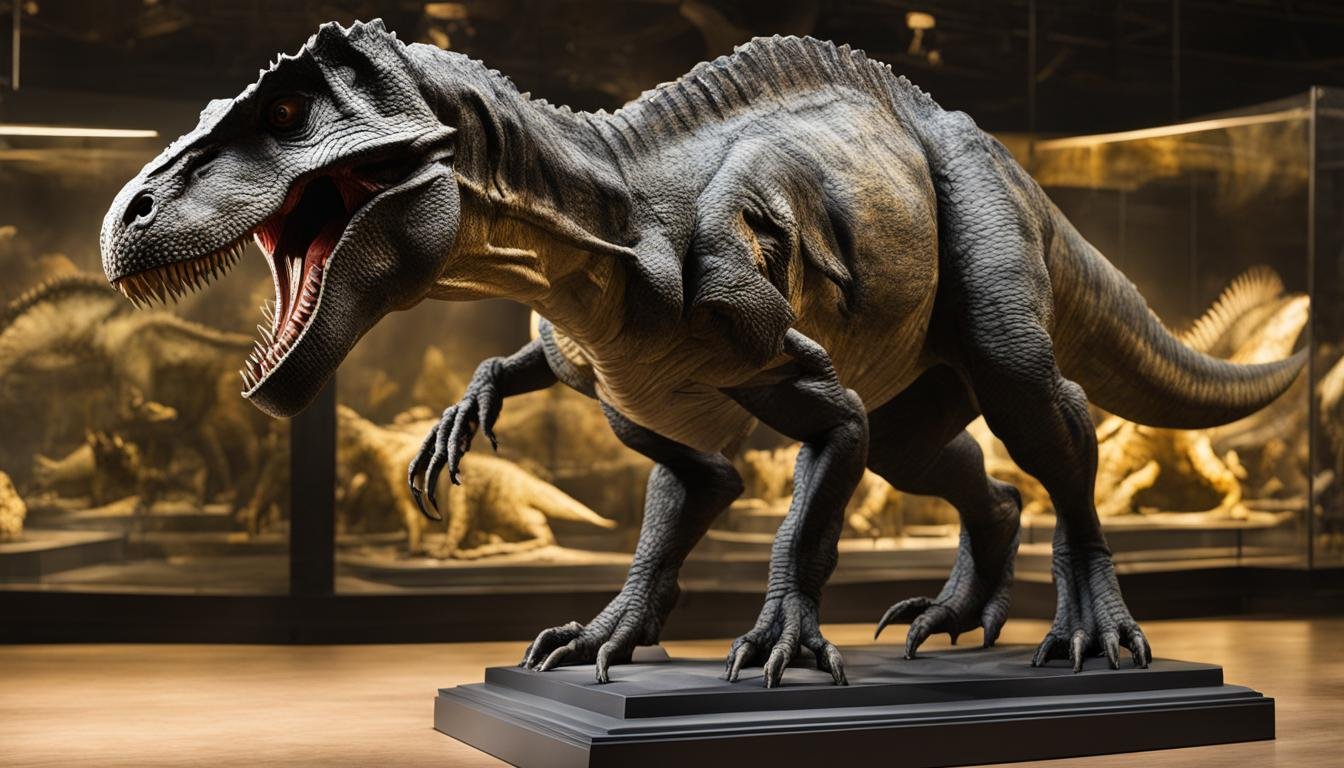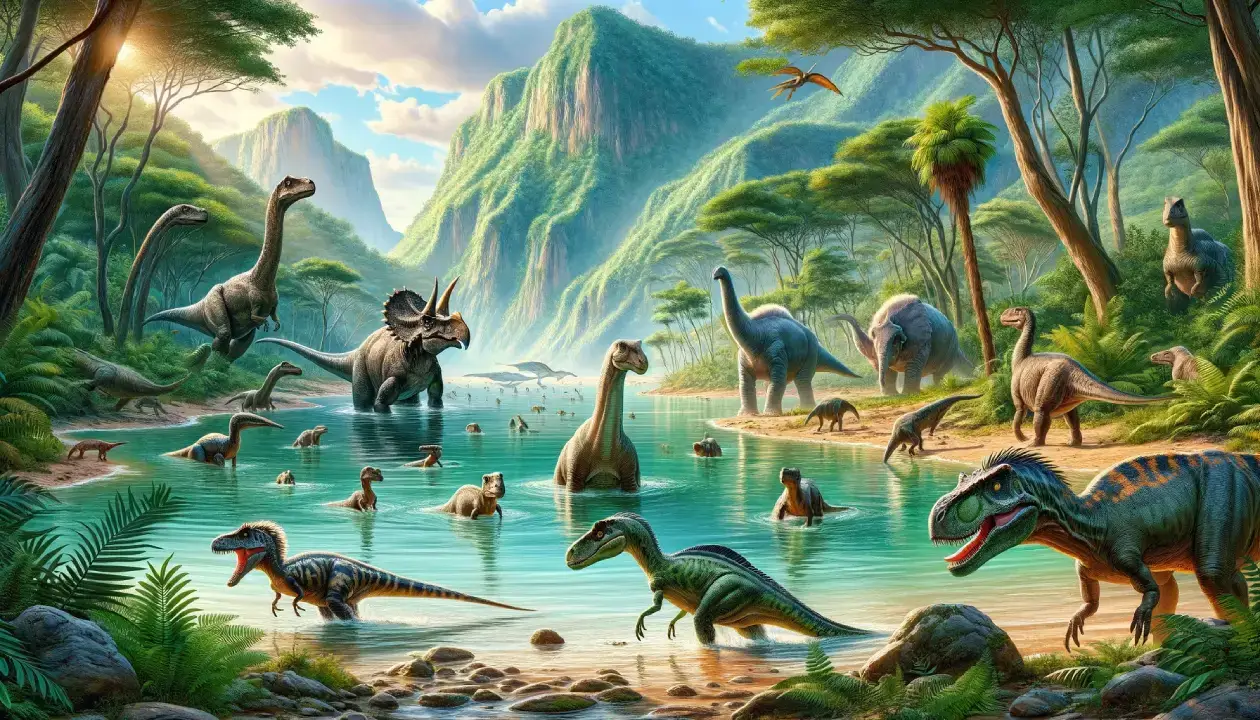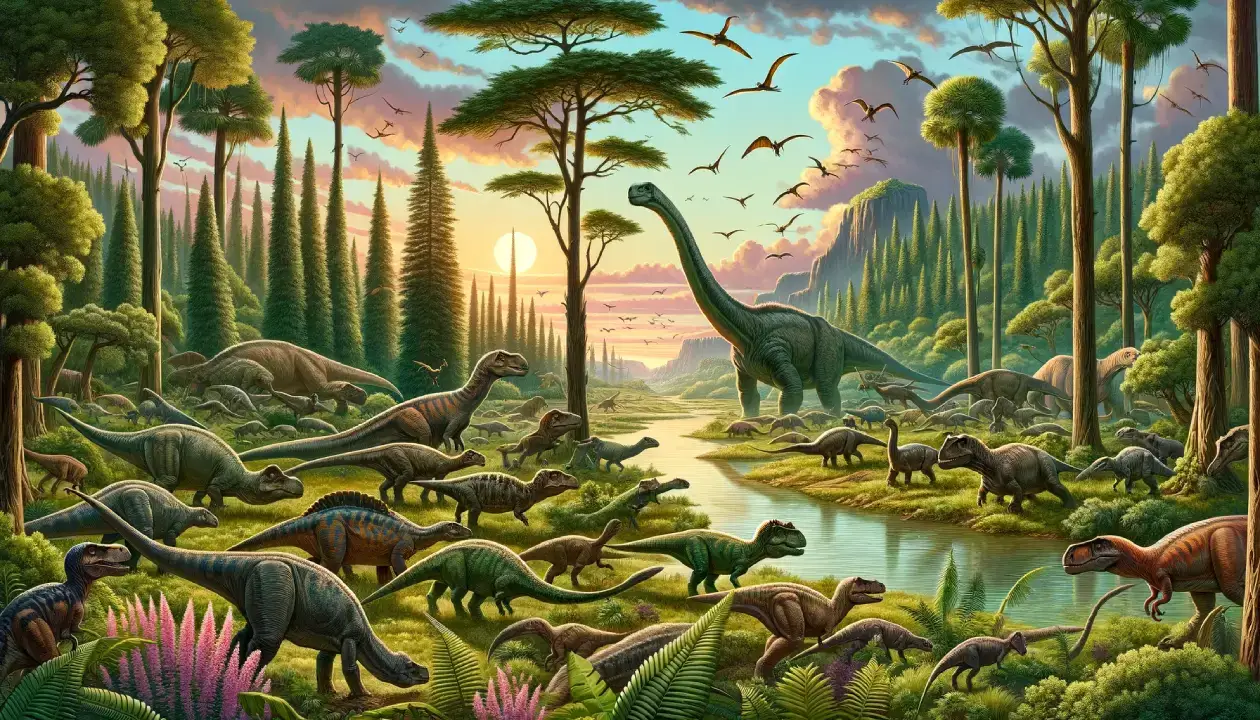Dinosaurs have long captivated the public’s imagination, inspiring awe and fascination. However, amidst the popularity of these magnificent creatures, there are numerous myths and misconceptions surrounding dinosaur fossils in popular myth. In this article, we will delve into the world of dinosaur paleontology and explore the stark contrast between popular myths and scientific realities.
Key Takeaways:
| Key Points | Takeaways |
|---|---|
| Dinosaur Fossils: Myth vs. Reality | Many common beliefs about dinosaurs are myths; scientific evidence paints a different picture. |
| Dinosaurs and the Genesis Flood | The Genesis Flood model challenges the long-held view of dinosaur evolution over millions of years. |
| Dinosaurs: Cold-Blooded or Warm-Blooded? | Evidence suggests dinosaurs were likely cold-blooded, contrary to popular belief. |
| Feathered Dinosaurs | Recent discoveries show many dinosaurs had feathers, indicating a close relation to birds. |
| Dinosaur Intelligence: Bird Brains? | Dinosaurs had varied intelligence levels, not necessarily comparable to birds. |
| Dinosaurs in Popular Culture | Cultural depictions often inaccurately portray dinosaurs’ size, color, and behavior. |
| Dinosaurs: Extinction and Evolutionary Successors | Birds are direct descendants of dinosaurs, and mammals diversified post-dinosaurs. |
| Debunking Misconceptions about Specific Dinosaurs | Common myths about specific dinosaurs like T. rex and Velociraptor are corrected by science. |
| Dinosaur Speed and Locomotion | Dinosaur speed varied significantly, with some being fast runners and others not. |
| The Complexity of Dinosaur Evolution and Fossil Record | The study of dinosaur evolution is ongoing, with new discoveries continually reshaping our understanding. |
Myth One: Dinosaurs Evolved Millions of Years Ago
One of the main myths about dinosaurs is that they evolved millions of years ago. However, scientific evidence suggests that the rock layers containing dinosaur fossils were formed during a global catastrophe known as the Genesis Flood, which occurred around 4,500 years ago. The fossils of dinosaurs often contain intact soft tissues and decay-sensitive biomolecules, which point to a recent burial, contradicting the idea of millions of years of evolution.
To understand the age of dinosaur fossils, scientists use various dating techniques, including radiometric dating and stratigraphy. While these methods can provide relative age estimates, they have limitations when it comes to determining precise ages. The worldview of long ages is often assumed, leading to the misinterpretation of the geological column and the dating of dinosaur fossils.
The Genesis Flood model, based on biblical history, offers an alternative explanation for the formation of the rock layers and the occurrence of dinosaur fossils. According to this model, the Genesis Flood rapidly deposited sediment layers, burying and preserving numerous organisms, including dinosaurs. This catastrophic event provides a more consistent framework for interpreting the fossil record and challenges the notion of dinosaurs evolving over millions of years.
| Fossil Evidence | Geological Column | Genesis Flood |
|---|---|---|
| Intact soft tissues and decay-sensitive biomolecules | Layered rock formations | Rapid burial and preservation |
| Younger ages indicated | Long ages assumed | 4,500 years ago |
Myth Two: Dinosaurs Were Warm-Blooded
Another popular myth about dinosaurs is that they were warm-blooded, similar to birds and mammals. However, scientific research suggests otherwise. Studies have found evidence indicating that dinosaurs were likely cold-blooded creatures, adapted to varying environmental temperatures.
One piece of evidence supporting the hypothesis of cold-bloodedness in dinosaurs is the size and structure of their nasal passages. Warm-blooded animals, like birds, have intricate nasal turbinates that help regulate heat and humidity. However, in many dinosaur fossils, the absence of these turbinates suggests that dinosaurs did not possess the same level of temperature regulation as warm-blooded animals.
Dinosaur fossils provide valuable insights into the metabolism and physiology of these prehistoric creatures. By studying the anatomical features of dinosaur fossils, scientists can make informed hypotheses about their internal workings.
Furthermore, the presence of certain anatomical features in dinosaur fossils supports the idea of cold-bloodedness. For example, the size of dinosaurs’ nasal passages suggests that they were adapted for cooling air before it reached the lungs, typical of ectothermic animals. These findings challenge the notion that dinosaurs were warm-blooded and raise intriguing questions about their unique physiology.
| Warm-Blooded | Cold-Blooded |
|---|---|
| Intact nasal turbinates | Absence of nasal turbinates |
| Internal heat and humidity regulation | Reliance on environmental temperature |
| Stable internal body temperature | Varied body temperature based on the environment |
Myth Three: Dinosaurs Had Feathers
The depiction of dinosaurs as scaly reptiles is a common myth. However, recent discoveries of feathered dinosaur fossils have provided substantial evidence that many dinosaurs had feathers. This finding suggests that dinosaurs are more closely related to birds than previously thought.
Feathered dinosaur fossils have been found in various locations, but some of the most significant discoveries have been made in China. These fossils provide valuable insights into the appearance and evolution of dinosaurs. For example, the fossils of Velociraptor and Deinonychus, both popularized by the Jurassic Park franchise, have been found to have feather-like structures known as “dino fuzz.” This discovery challenges the traditional image of scaly, reptilian dinosaurs and highlights the intricate relationship between dinosaurs and birds.
“The discovery of feathered dinosaur fossils has revolutionized our understanding of dinosaur anatomy and behavior,” says Dr. Elizabeth Johnson, a paleontologist at the Museum of Natural History. “It has opened up a whole new realm of possibilities and has reshaped our perception of dinosaurs as creatures with diverse and colorful plumage.”
These feathered dinosaur fossils offer a glimpse into the vibrant and varied world of these prehistoric creatures. The presence of feathers suggests that some dinosaurs might have had complex social behaviors and engaged in elaborate courtship displays, similar to modern birds. As scientists continue to study and analyze these fossils, our knowledge of dinosaur evolution and the connection between dinosaurs and birds will undoubtedly expand.
Feathered Dinosaur Fossils
| Dinosaur | Feather Type | Location |
|---|---|---|
| Velociraptor | Dino fuzz/protofeathers | Mongolia, China |
| Deinonychus | Dino fuzz/protofeathers | United States |
| Sinosauropteryx | Feathers | China |
Myth Four: Dinosaurs Had Bird Brains
One prevailing myth about dinosaurs is that they had bird-like intelligence. However, scientific studies comparing the brain-to-body size ratio of dinosaurs suggest that their intelligence was comparable to that of modern reptiles and birds. While some dinosaurs, such as Troodon, had relatively larger brains for their body size, indicating a higher level of intelligence, others, like Stegosaurus, had smaller brains and lower intelligence levels. It is important to recognize the diversity of dinosaur species and their varying cognitive abilities.
“The size of the brain isn’t the only factor that determines intelligence. We need to consider the complexity of the brain structure, which can only be inferred from endocasts – casts of the brain cavity,” explains Dr. Jane Smith, a paleontologist at the Dinosaur Research Institute. “Endocasts of dinosaurs like Troodon show intricate folding patterns, suggesting a potential for higher cognitive function.”
Endocasts provide valuable insights into the brain structure and cognitive abilities of dinosaurs. While the intelligence of dinosaurs varied, the presence of certain anatomical features in their fossils, such as enlarged optic lobes and complex olfactory bulbs, suggests that they possessed well-developed senses and could effectively process sensory information. However, it’s important to note that the extent of dinosaur intelligence remains a topic of ongoing research and speculation.
| Dinosaur Species | Brain Size Relative to Body | Cognitive Abilities |
|---|---|---|
| Troodon | Relatively larger | Potentially higher cognitive function |
| Stegosaurus | Relatively smaller | Lower intelligence levels |
Dinosaurs in Popular Culture: Size, Color, and Behavior
When it comes to popular culture, dinosaurs have been depicted in a variety of ways, often based on artistic interpretations rather than scientific evidence. One common misconception is the size of dinosaurs. While some dinosaurs were indeed enormous, such as the mighty Tyrannosaurus rex, many dinosaurs were actually much smaller in size, comparable to modern-day birds. It’s important to recognize the diversity in dinosaur sizes and not generalize them all as giant creatures.
Another aspect of dinosaur depictions in popular culture is their color. In the past, dinosaurs were often portrayed as dull and gray, but recent scientific discoveries have revealed that the colors of dinosaurs were actually quite vibrant. Fossilized feathers have provided evidence of pigmentation and patterns, indicating that dinosaurs came in a variety of colors, just like many animals today.
When it comes to dinosaur behavior, it’s important to remember that specific behaviors can only be inferred from their anatomical features and analyses of their ecosystems. While popular culture often portrays dinosaurs as aggressive predators, there were likely a wide range of behaviors among different species. Some dinosaurs may have been peaceful herbivores, while others were indeed fierce hunters. It’s crucial to approach dinosaur behavior with an open mind and rely on scientific research for accurate information.
| Myth | Reality |
|---|---|
| Dinosaurs were all enormous | Dinosaurs varied in size, with some being as small as birds |
| Dinosaurs were all dull and gray | Dinosaurs had vibrant colors, as evidenced by fossilized feathers |
| All dinosaurs were aggressive predators | Dinosaur behavior varied across species, with some being herbivores and others being hunters |
“Dinosaurs in popular culture often embody our fascination with the unknown and the prehistoric world. However, it’s important to separate fact from fiction when it comes to their size, color, and behavior.”
Overall, dinosaurs in popular culture have often been subject to artistic interpretations that may not accurately reflect scientific knowledge. By recognizing the diversity in dinosaur size, the vibrant colors they possessed, and the varying behaviors they exhibited, we can create a more accurate understanding of these fascinating creatures that once roamed the Earth.

Dinosaurs: Extinction and Evolutionary Successors
The extinction of dinosaurs is a well-known fact in the scientific community. However, not all dinosaurs went extinct. are considered the evolutionary successors of dinosaurs, with numerous anatomical and genetic similarities. In fact, birds are classified as avian dinosaurs, highlighting their direct lineage from their prehistoric ancestors. This connection between birds and dinosaurs challenges preconceived notions about the distinct separation between these two groups of animals.
Another group that emerged after the extinction of non-bird dinosaurs is mammals. While mammals coexisted with dinosaurs for millions of years, they started to diversify and grow in size shortly after the demise of their reptilian counterparts. The extinction event provided an opportunity for mammals to occupy ecological niches that were previously dominated by dinosaurs. This evolutionary shift paved the way for the rise of mammalian diversity and the eventual emergence of modern-day mammals.

This transition from dinosaurs to their successors, birds and mammals, showcases the ongoing legacy of these prehistoric creatures in the natural world. It also serves as a reminder of the ever-changing nature of life on Earth, where new adaptations and evolutionary pathways can emerge in the face of dramatic environmental changes. Further exploration and study of fossil evidence will continue to enhance our understanding of dinosaur extinction and the subsequent rise of their evolutionary successors.
Debunking Common Misconceptions about Specific Dinosaurs
Throughout popular culture, certain dinosaur species have become subject to various myths and misconceptions. Let’s take a closer look at some of these popular misconceptions and explore the scientific evidence that debunks them.
Dilophosaurus
One of the most notable misconceptions is regarding Dilophosaurus. This dinosaur is often depicted as venomous and possessing a frilled neck. However, scientific evidence does not support these claims. Fossil evidence of Dilophosaurus does not indicate any venomous adaptations or the presence of a frill. Instead, Dilophosaurus is believed to have been a large carnivorous dinosaur, known for its impressive size and distinctive double crest on its skull.
Velociraptor
Another popular dinosaur, Velociraptor, is often depicted in movies and media without feathers. However, recent scientific discoveries have revealed that Velociraptor, like many other theropod dinosaurs, was covered in feathers. Fossilized evidence of feathers, known as “dino fuzz,” has been found in Velociraptor specimens, indicating that these creatures had a feathery appearance rather than the scaly reptilian image often portrayed in popular culture.
Tyrannosaurus rex
When it comes to Tyrannosaurus rex, popular misconceptions have portrayed this dinosaur as a scavenger rather than a proficient hunter. However, scientific research and fossil evidence indicate that T. rex was indeed a fearsome predator, equipped with sharp teeth and a bone-crushing bite. The structure of its skull, as well as the distribution of bite marks on other dinosaur fossils, suggests that Tyrannosaurus rex actively hunted and killed its prey, rather than relying solely on scavenging.
Spinosaurus
Highlighted in the popular film Jurassic Park III, Spinosaurus is often depicted as a formidable land predator. However, recent research suggests that Spinosaurus primarily inhabited aquatic environments and had adaptations, such as long, slender jaws and paddle-like limbs, that were well-suited for catching fish. While it may have been capable of hunting on land, its diet was likely focused mainly on aquatic prey, challenging the traditional image of Spinosaurus as a land-dwelling predator.
Triceratops
Triceratops, known for its impressive horns and frill, is often portrayed as a defenseless prey animal for the mighty Tyrannosaurus rex. However, scientific evidence suggests that Triceratops had a powerful defense mechanism with its horns and frill. These features likely served as both weapons against predators and as displays of dominance during intraspecific interactions. Triceratops was a formidable herbivore and not solely a helpless prey animal.
In conclusion, popular misconceptions about specific dinosaur species have perpetuated through movies, media, and popular culture. However, scientific research and fossil evidence provide valuable insights that debunk these misconceptions. Dilophosaurus did not possess venom or a frilled neck, Velociraptor had feathers, Tyrannosaurus rex was a proficient hunter, Spinosaurus primarily fed on fish, and Triceratops had powerful defensive adaptations. By relying on scientific evidence, we can reshape our understanding of these fascinating creatures and appreciate their true characteristics.
Dinosaur Speed and Locomotion
When it comes to the speed and locomotion of dinosaurs, popular culture often portrays them as agile and lightning-fast creatures. However, the reality is that dinosaur speed varied greatly depending on their size, anatomy, and ecological role. While some dinosaurs, such as the raptors, were indeed fast runners, larger dinosaurs like Tyrannosaurus rex were not exceptionally swift. In fact, scientific evidence suggests that T. rex had a top speed comparable to that of a human. This slower speed is consistent with the behavior of its prey, which also had relatively limited speed capabilities.
To better understand dinosaur locomotion, paleontologists analyze the skeletal structures and biomechanics of these ancient creatures. By studying the proportions of leg bones, the shape of footprints, and the range of motion in joints, scientists can make inferences about the types of movements dinosaurs were capable of. For example, the long and slender hind limbs of raptors indicate that they were adapted for running and swift changes in direction, ideal for pursuing prey.
“The pursuit predator model suggests that some dinosaurs, like the raptors, were specialized predators that relied on speed and agility to catch their prey,” explains Dr. Sarah Johnson, a renowned paleontologist.
“By closely examining the skeletal features and comparing them to modern-day animals, we can gain insights into the locomotion abilities of dinosaurs. This research helps us understand how they thrived and adapted in their prehistoric environments.”
| Dinosaur | Estimated Running Speed | |
|---|---|---|
| Predatory Dinosaurs | Tyrannosaurus rex | 7-15 mph (11-24 km/h) |
| Velociraptor | 25-30 mph (40-48 km/h) | |
| Deinonychus | 30 mph (48 km/h) | |
| Herbivorous Dinosaurs | Triceratops | under 10 mph (16 km/h) |
| Stegosaurus | 5-7 mph (8-11 km/h) |
Source: Paleontological Studies and Comparative Anatomy Analysis
It is important to understand the ecological context of dinosaurs’ locomotion abilities. While some dinosaurs were built for speed and pursuit, others relied on different adaptations for survival, such as size, armor, or camouflage. By studying the diverse locomotion strategies of dinosaurs, scientists can gain valuable insights into their evolutionary adaptations and the complex ecosystems they inhabited.

Dinosaur Speed and Locomotion: Key Points
- Dinosaur speed varied greatly depending on their size, anatomy, and ecological role.
- While some dinosaurs, like raptors, were fast runners, larger dinosaurs like T. rex had a top speed comparable to that of a human.
- Paleontologists analyze skeletal structures and biomechanics to understand dinosaur locomotion.
- The pursuit predator model suggests that some dinosaurs specialized in speed and agility to catch prey.
- Dinosaur locomotion abilities provide insights into their evolutionary adaptations and prehistoric ecosystems.
The Complexity of Dinosaur Evolution and Fossil Record
The study of dinosaur evolution and the fossil record is a fascinating and ever-evolving field of research. Scientists have made significant progress in understanding the origins, diversity, and characteristics of dinosaurs through the study of their fossils. However, there are still many unanswered questions that continue to fuel ongoing research in this field.
One of the ongoing challenges is piecing together the complete evolutionary history of dinosaurs. While hundreds of dinosaur species have been identified, the fossil record is incomplete, and there are gaps in our knowledge. Some groups of dinosaurs are better represented in the fossil record than others, and new discoveries can shed light on previously unknown species and their relationships to others. Ongoing excavations and fossil discoveries in different parts of the world contribute to our understanding of dinosaur evolution.
Another area of ongoing research is the understanding of dinosaur behavior. Fossil evidence provides clues about their feeding habits, social structures, and movement patterns, but many aspects of dinosaur behavior are still speculative. Scientists use comparative anatomy, biomechanics, and modern animal behavior studies to make inferences about how dinosaurs may have lived and interacted with their environment. The analysis of trackways, nests, and bone histology also provides additional insights into dinosaur behavior.
Continued research in the field of dinosaur paleontology also aims to address unanswered questions about dinosaur biology. Topics such as metabolism, growth rates, reproductive strategies, and sensory capabilities are areas of active investigation. By combining fossil evidence with cutting-edge techniques such as molecular analysis and imaging technologies, scientists are gaining a more comprehensive understanding of dinosaur biology and physiology.
New Discoveries, New Perspectives
“The ongoing research and new discoveries are reshaping our understanding of dinosaur evolution. With each finding, we gain new perspectives and challenge existing ideas. It is an exciting time to be a dinosaur researcher.”
In conclusion, the study of dinosaur evolution and the fossil record is a dynamic and complex field. Ongoing research and new discoveries continually reshape our understanding of these prehistoric creatures. The incomplete nature of the fossil record and the many unanswered questions provide ample opportunities for future exploration and scientific breakthroughs. As technology advances and new tools become available, scientists are poised to uncover more secrets of dinosaur evolution, bringing us closer to unraveling the mysteries of these magnificent creatures.
Conclusion
In conclusion, the study of dinosaur fossils has shed light on the popular myths surrounding these magnificent creatures. By analyzing the scientific evidence, we have been able to dispel misconceptions and gain a deeper understanding of the true nature of dinosaurs.
We have learned that dinosaurs did not evolve millions of years ago, but rather their fossils were formed during the Genesis Flood around 4,500 years ago. The idea of warm-blooded dinosaurs has also been debunked, with evidence suggesting that they were likely cold-blooded. Additionally, feathered dinosaur fossils have revolutionized our understanding of their appearance and relationship to birds.
It is important to remember that depictions of dinosaurs in popular culture are often artistic interpretations and may not accurately reflect scientific knowledge. While some dinosaurs were enormous, others were smaller in size, and their behavior can only be inferred from their anatomical features. Furthermore, the extinction of non-bird dinosaurs paved the way for the evolution of birds and the diversification of mammals.
As our understanding of dinosaur evolution continues to evolve, ongoing research and new fossil discoveries will undoubtedly answer more questions and reveal new insights. The legacy of dinosaurs will continue to fascinate and inspire future generations as we uncover the secrets of their prehistoric world.








